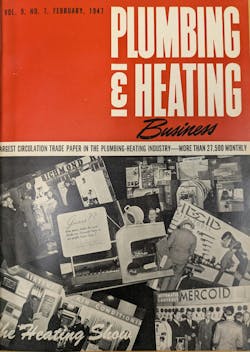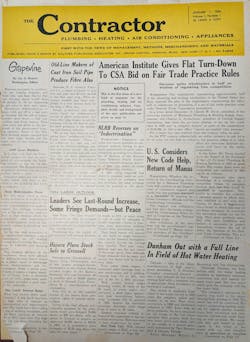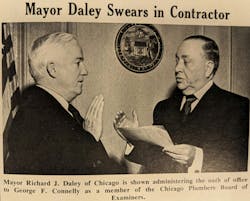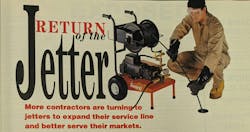
CONTRACTOR was the brainchild of Publisher Herbert Walther, a man noted for his biting wit, no-nonsense attitude and comprehensive industry knowledge. Walther learned his trade in the pages of Plumbing and Heating Business, a magazine which was the official organ of the National Association of Plumbing Contractors back in the 1930s and ‘40s.
Walther was a true innovator in the business-to-business publishing game. When it came time to found his own magazine (out of a cramped office on Lexington Ave. in New York City), he stressed that the new venture was independent, not beholding to any organization, association, union or manufacturing concern. That independence put his new publication 100% at the service of the reader. The plan was that this would, in time, create a wider, more loyal audience of high value to advertisers. The plan worked.
John Carlson was the first Editor of CONTRACTOR—a title that morphed over the decades to Chief Editor/Editor-in-Chief as staff expanded, then to Editorial Director as business models changed, and even briefly to Content Director as the brand staked out new territory on the World Wide Web.
Following Carlson came Seth Shepard, who directed editorial operations almost 30 years until his retirement in 1984. Over the years the editorial torch passed in turn to John Schweitzer, Bob Miodonski, Robert Mader (more about both Bobs later in this feature) and finally, in 2018, to myself.
Over the years CONTRACTOR has featured columns by such industry legends as Dan Holohan, Matt Michel, Dave Yates, Mark Eatheron, Al Schwartz, Pat Linhardt and countless others. While my sympathies are obviously on the editorial side, the continuing success of the brand has been the work of publishers including William Adams and Bill Everham, of our several art directors (including our current one, Susan Lakin), our sales team, support staff and so many more.
It has been a remarkable 70 years, and all made possible thanks to you, our readers. We hope to keep bringing you the news, insights and expert know-how that will help you run a better business for decades to come.
TIMELINE
1950s
The first issue of CONTRACTOR is published in January of 1954. Initially The CONTRACTOR, it prints twice a month at a price of 50 cents an issue.
Plumbing Manufacturers International (then known as the Plumbing Brass Institute) is founded (also in 1954).
Infrastructure—including water and wastewater systems—is a key concern of the Eisenhower Administration.
High interest in modernization and improvement loans.
Influx of people joining the skilled trades; early issues worried the supply of journeymen plumbers would far exceed the demand.
First steps towards the development of a national plumbing code.
1960s
Worries over excessive government regulation.
Big question: are you charging your customers enough?
The rise of women as decision-makers in bath and kitchen design and remodeling.
Plastic pipe enters the market to skepticism, controversy, and some who see enormous potential in the new materials.
CONTRACTOR begins to print with more and more color.
Seth Shepard’s regular column “As I See It” runs as a boxed item on the cover of each issue of CONTRACTOR.
Some larger plumbing companies start using computers to help with their business.
1970s
CONTRACTOR begins to develop longer, feature-style stories.
In response to growing concerns about pollution, the Nixon Administration establishes the EPA in 1970.
The Occupational Safety and Health Administration is founded in 1971.
The Safe Drinking Water Act is passed in 1974.
An outbreak of pneumonia occurs at a convention of the American Legion in Philadelphia. The causative agent was identified as a previously unknown strain of bacteria, subsequently named Legionella.
Rising gas prices become a concern for fleet managers.
The first software tools for modeling buildings (BIM) come on the market.
Herb Kohler initiates “The Bold Look of KOHLER” bringing luxury kitchen and bath fixtures to the mass market.
Solar water heating systems rise in popularity.
Sloan introduces the hands-free faucet.
The first low-flow toilets (at ¾ of a gallon) come on the market.
1980s
The power of union plumbing begins to wane as merit shops rise in popularity.
CONTRACTOR undergoes an editorial re-design that includes a new logo, more color photography, and an emphasis on columnists covering a variety of industry “beats” (management, plumbing, law, taxes etc.).
The Lead Contamination Control Act becomes federal law.
Columnist Irving Blackman writes about the looming shortage of skilled workers.
Mobile phones become a game changer for managing technicians in the field.
CONTRACTOR begins publishing larger issues once per month.
Building on technology developed in the 1950s, Viega introduces copper press fittings to the North American market.
AERCO introduces the first modulating condensing (mod-con) boiler to the North American market.
1990s
The EPA introduces the Lead and Copper Rule, setting maximum levels for lead and copper contaminants leached into drinking water from service lines.
The International Code Council is formed.
The US Green Building Council is formed. LEED 1.0 begins pilot testing.
A court decides a class action suit involving defects and damages due to polybutylene (Poly-B) pipe for $950 million.
CONTRACTOR’s online home, www.contractormag.com, is founded. Digital ads become an increasingly more important part of the brand’s business model.
2000s
LEED 2.0 is launched.
The 2003 edition of the Uniform Plumbing Code is developed—for the first time—through a true consensus process.
CONTRACTOR enters the arena of social media with channels on Twitter, YouTube and LinkedIn.
The first edition of CALGreen (containing, at that time only voluntary measures) is published in 2008.
A CONTRACTOR investigation finds scalding water in more than 91% of hotel rooms.
2010s
LEED v4 released.
The Water Demand Calculator—the first statistically-based pipe sizing method since Hunter’s Curve in the 1940s—is published.
The Flint, MI water crisis. Of 15 people brought up on charges, only one person has been successfully convicted.
“Megadrought” in the Southwestern states makes water conservation and access a primary concern for administrators, utilities and policy-makers.
After decades with a bright red logo, the CONTRACTOR logo turns blue (and, briefly, lower-case) as part of a company-wide rebranding effort.
Berkeley, CA, in one of the first such local ordinances, bans the installation of natural gas-powered appliances (including water heaters) in new construction.
2020s
Plumbing is designated an essential occupation during the COVID pandemic.
Publishing is also deemed essential. Luckily, most of the staff of CONTRACTOR are already working remotely.
Supply chain problems related to the pandemic halt or slow many construction-related projects. Plumbers working new construction move quickly to adapt.
PFAS or "Forever Chemicals" in the drinking water supply become a growing concern.
Artificial Intelligence explodes on the scene with applications in project scheduling, customer relations, predictive maintenance and much more.
A Bloomberg report estimates that the US is expected to be 550,000 plumbers short by 2027.
Green Buildings, Scalding Water and SARS
Former Chief Editor Bob Miodonski looks back at his time with CONTRACTOR.
Advancements Enable Water Conservation
Former Senior Editor Candace Roulo looks at evolving water technology.
In Memoriam: Bob Mader
No history of CONTRACTOR would be complete without special mention of Bob Mader. A graduate of Notre Dame, Bob came to CONTRACTOR back in 1984, working first as Associate Editor, later as Managing Editor. He took the top job as Editorial Director in 2007 and served in that capacity until 2018—more than 34 years with the publication.
Bob was a tireless champion of the industry, believing that the plumbing and heating trades protected the health of the public, and were the backbone of modern infrastructure. He was an early proponent of the Green Buildings/Green Cities movement, using his editorial voice to highlight water and energy conservation efforts, as well as renewable energy applications using geothermal and solar. He was early to grasp the importance of prefabrication, IoT, Big Data, the Digital Twin and other key industry innovations.
Bob worked to bring the CONTRACTOR brand into the digital age, dedicating new resources to the website, contractormag.com, and promoting our first forays into social media.
Bob passed away unexpectedly in 2021. Many industry tributes followed, including one from frequent columnist and founder of Service Roundtable, Matt Michel, who wrote, “In his role at CONTRACTOR, and other publications, Bob was incredibly influential, but it never went to his head. He was always humble, committed to his craft, excellent in his work, and forever maintaining a dry, sardonic sense of humor.”
About the Author
Steve Spaulding
Editor-in-Chief - CONTRACTOR
Steve Spaulding is Editor-in-Chief for CONTRACTOR Magazine. He has been with the magazine since 1996, and has contributed to Radiant Living, NATE Magazine, and other Endeavor Media properties.


















